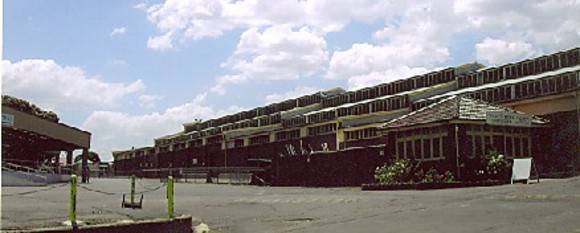| Back to search results » | Back to search page » |
|
Royal Agricultural Society Showgrounds
Location300-380 Epsom Road,, ASCOT VALE VIC 3032 - Property No B6886
File NumberB6886LevelState |
|
Statement of Significance
What is significant? Developed as the base for the Royal Agricultural Society of Victoria and the home of the Royal Melbourne Show from 1883, the Royal Melbourne Showgroundsis Victoria's largest and pre-eminent agricultural showground complex. Until 2005 the substantial grounds contained a large number of buildings and a range of building types, continuously developed and added to until the site was quite crowded. The most distinctive building type was the large, long red-brick or concrete basilica-like halls, built between 1910 and the 1930s, with lower side-aisles and a central raised section with a clerestory between, where animals were exhibited. There were also many other structures built for various purposes that were an integral part of the show, such as: the Arts & Crafts Pavilion of 1904 (demolished), built to display the foods and crafts made mainly by country women; the Royal Luncheon Rooms of 1916; an Administration Building; various pavilions displaying agricultural machinery; and in the mid twentieth century striking outlets for various banks and a chair lift. Many semi- permanent side-show structures were also scattered across the site, attesting to the site's secondary purpose of providing amusements to attract crowds and add to the carnival atmosphere. The Pie-in-the-Sky Kiosk was added in 1976. All this was focussed on the Grand Arena surrounded by grandstands, built from the 1920s to the 1970s.
In 2005-6 the site was virtually cleared, leaving at least fifteen historic structures, some relocated. The site underwent a substantial redevelopment at this time, increasing open space and providing new buildings considered to be more adaptable, in order to increase the viability of the site, whilst retaining it as the base for the Show, Melbourne's most popular event.
How is it significant? The Royal Agricultural Showgrounds and the remaining historic structures are significant for architectural, historic, and social reasons at the State level.
Why is it significant? As a complex, the Royal Agricultural Showgrounds have economic, historical and cultural significance as the largest agricultural show complex in Australia, a vital part of Australia's oldest major industry, and an important location for the enactment of national identity. The site and its Show are of cultural significance as the largest single public event held annually in Victoria, attracting in excess of 700,000 persons each year. The Show itself is significant for demonstrating the importance of the metropolitan area as a focus for the continuing exchange of ideas and experience of agricultural producers across Victoria. It also maintains a fundamental principle of the Show, showcasing rural life to Melbourne's urban population.
The remaining structures at the Showgrounds are the primary illustration of the significant activities of the Royal Agricultural Society of Victoria in the past one hundred years. It is by far the largest, most substantial and most significant place of its kind in Victoria, and within Australia is rivalled only by the former Sydney Showgrounds.
The various pavilions and halls built for the showing of animals such as cattle, pigs, dogs, and horses are essentially unique to this site, and certainly this is the largest concentration of such structures in Victoria. They are distinctive for their basilica-like form, and the simple architectural expression, evocative of vernacular farm buildings. The Pig or Rural Pavilion is the earliest remaining pavilion (1903) and the most evocative in this regard. The Centenary Hall is important as virtually the only such hall with a notable architectural expression, being a restrained Moderne building typical of the 1930s. The Clydesdale Pavilion demonstrates the original agricultural role of horses at the Show, while the remnants of the once extensive horse boxes demonstrate their later importance as 'show' and performance animals, and the main agricultural use of the site outside the formal Show.
The surviving grandstands are important for providing evidence for the parading of large numbers of animals, demonstrating techniques and equipment and events once held in the Grand Arena. The Royal Luncheon Rooms are important as an early building on the site for necessary ancillary purposes, and has a notable Edwardian character. The Pie Sign / Kiosk is important as the only reminder of the crassly commercial side-show aspect that has long been associated with the Show. The Woodfull Pavilion is important as the most architecturally impressive hall on the site, complemented by nineteenth century statues of Queen Victoria and Prince Albert. The nineteenth century marble 'Big Bull' is important as a symbol of nature tamed in the service of man, a theme of the Show, and the Stockman figure is important for memorialising this quintessentially Australian country worker.
Classified: 26/06/2006
Group
Community Facilities
Category
Showground




